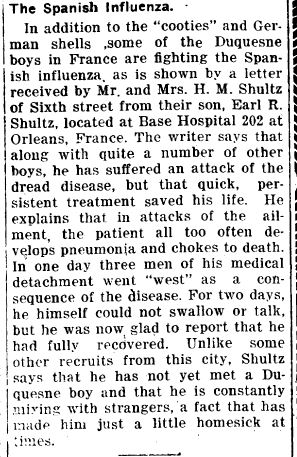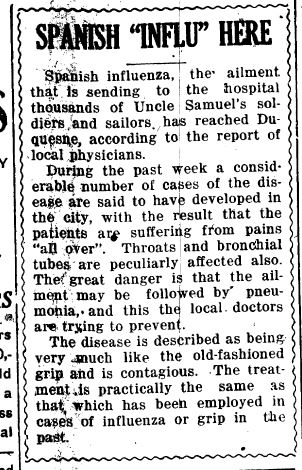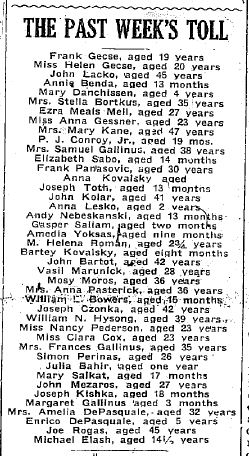Please note: Some of the newspaper articles appear to be small and might be difficult to read. If you encounter that problem, just click on the article, position the magnifying glass over the article and press enter. by doing so, you will be able to increase the magnification and improve the readability. Sorry for the inconvenience. – Jim
I would assume that we all have been watching the media coverage of the spread of the Corona Virus COVIC-19. I hope that you are taking the recommended precautions to keep yourself safe and well. However, as I continued to listen to the news of the spread, it reminded me of a Duquesne News article that I had bookmarked a number of years ago. There has never been a more appropriate time or reason to share it with you than now, with the growing worldwide health concerns that we are experiencing.
Did you know that almost 102 years ago, the City of Duquesne suffered from the devastating effects of another global pandemic? Known as the Spanish Flu (H1N1 virus) Pandemic of 1918, the deadliest in history, infected an estimated 500 million people worldwide, about one-third of the planet’s population, and killed an estimated 20 million to 50 million victims, including some 675,000 Americans.
In Duquesne, in a period of just 7 weeks, 266 people lost their lives as a result of influenza. The sickness did not discriminate between the young and old. Older citizens as well as infants and children perished. The wealthy of Duquesne as well as those who barely eked by financially, fell victim to the Spanish Flu.
In this post, I have assembled a number of articles from the Duquesne Times that reported on the horror of the disease and the effects on the residents. The similarities on the timing and spreading of the virus appears to be remarkably comparable to the current timeline and spread of the Coronavirus.
On page 6 of the September 27, 1918 edition of The Duquesne Times, the existence of The Spanish Flu was first mentioned. In a column that published reports and letters from enlisted Duquesne boys battling in World War I, young Earl R Shultz wrote from Orleans, France:
On October 4, 1918, just one week after the report about Earl Shultz’s battle with the Spanish Flu, the first report of the deadly influenza actually arriving in Duquesne was published. This time the information was front page news, but the article’s diminutive size and downplayed content, didn’t really provide a sense of urgency or concern.
One week after the initial anouncement that the Spanish Flu had arrived in Duquesne, the tone of the news took a dramatic and frightening turn. The suspected cases of the influenza had grown to 274 people in a little over one week, with no signs of relenting.
I found the section of the article titled “Donts For Influ” particularly interesting. The recommendations to guard against the flu were virtually identical to those that the CDC is recommended for the Coronavirus! Common sense prevails 102 years later!
- Avoid needless crowding
- Smother your coughs and sneezes
- The three C’s: clean mouth, clean skin, clean clothes
- Wash your hands
The following week’s edition of The Duquesne Times continued to report the dire situation in Duquesne. Buy October 18, 1918, there were 0ver 1200 residents who were sickened by the disease. The front page of the paper contained a proclamation by Mayor James S. Crawford urging people to follow the guideline of the public health officials and were warned to not place any credence in the false reports and rumors about the malady.
Front page headlines of The Duquesne News announced the toll of the epidemic for the following weeks as the death toll rose and well as providing hope as the number of people contracting the disease began to wane. Coupled with the jubilation felt with the surrender of Germany on November 11, 1918, life was returning to normal in Duquesne.
Finally, I am posing the published names and ages of victim of the pandemic. I am sure they are not all inclusive, but may answer some of the questions you might have about your ancestors.
And so, in closing, I wish you all well. Please pay careful attention to the guidelines provided by the CDC and your local authorities. I am so looking forward to hearing from you after our current problem passes.
Be well my friends!














Topical…really enjoyed the progression of the Spanish Flu in Duquesne and how it was handled by the populace. Thank you for the lists of the deceased. My grandfather, George Yarosik, was 28 when he passed, leaving a wife and three children. His widow married a widower from their village, Torysky SK, whose wife, Mary Cherpak was 23 at the time of her death. The age range of the victims was interesting as well.
Thank you for the timely story. I live in Michigan now. The Governor reported tonight that there are two cases in the state, I will be 92 on March 20. I have a flight departing on March 20. Maybe not I may be the only living 1945 graduate of Duquesne HS. I still enjoying reading your posts.
No my sister Mary Kulha is still living class of 1945
WOW Jim,Thank you so much for the post. It is quite interesting. Lets pray that all will take precautions and take this world situation serious! honeybez@verizon.net
I read a book about this flu “the great influenza” by John Barry. A good podcast to listen to about viruses is “this week in virology“ by Dr Vincent Racenello of Columbia university. John Hopkins has a web page scoreboard that is updated in real time with the lates reports. Google “Jhu covid 19” 3.4% fatality rate among reported cases. Normal flu season is about 0.1% fatality rate. Spanish flu was so deadly because h1n1 had not circulated for about 50 years.
I just read the article and I see my grandmother lost a baby boy in 1918. She had 8 girls and 3 boys but none of her boys lived. My mom was born in 1919.
Josephine, did you attend Holy Name school and your dear mom worked for the nuns.
I remember you as a pretty girl with beautiful curls.
Judy Trainor Schorr—-remember Sr. Rose Elizabeth?
Thanks Judy, I love when old friends connect. It’s been so amazing.
Thank you for posting this, One of my great aunts died during this pandemic,
My. Grandma Sadie died in 1918 also her infant she was 36:( Never got to meet her my dad was 2 yrs old.
Patricia the hunkey from munhall pa
Thank you so much, Jim. God bless you and yours and the “Duquesne Hunky”
Thanks for a great article. So many of the newspaper clippings are hard to find (even in our age of computers). Even though this new virus isn’t good, we are so much more informed & prepared than those poor souls were !
There is currently NO VACCINE for corona virus and there have been 14 deaths to date.
Read this: https://www.cdc.gov/flu/prevent/keyfacts.htm,
then go get your flu shot!
It’s not too late,
and data shows that only 32% of adults have gotten one in 2020.
It’s one thing to worry about corona, but complication of ‘the flu” have lead to the death 20,000 to 52,00 persons thru 2-29-20 :
https://www.cdc.gov/flu/about/burden/preliminary-in-season-estimates.htm
Hey, Louie, you ought to know about this. This too will pass, right?
Three more comments:
1. You can use ‘CTRL & +/-‘ to enlarge/shrink entire web page for easier reading.
2. My Uncle Eddie died in 1919; he was four years old.
3. If you are as old as Jim and I, you better get your pneumonia shots as well. Any virus weakens your system leading to bacterial pneumonia leading to death.
Do you know whether or not we can get tested by our own PC?
Jim,
Nice job of research. I’m guessing you noticed how many of the victim’s names were Slavonic. Interesting that one of the news articles notes the impact of the flu on the WWI production output of Duquesne Works, similar to what may happen with the current coronavirus. Hopefully this virus won’t be the horrific pandemic of 1918.
Fred Fraikor
Fantastic read! I had heard bits and pieces from my Mom who was 10 years old in 1918. Her family was spared the ravages of this awful scourge as I hope all of us are spared the corona virus. Thanks so much for your diligence. Love the Duquesne Hunky!!
A recent New York Times article covering the Spanish flu in Philadelphia noted that they had the second highest death toll after Pittsburgh…that was a new tidbit I was unaware of.